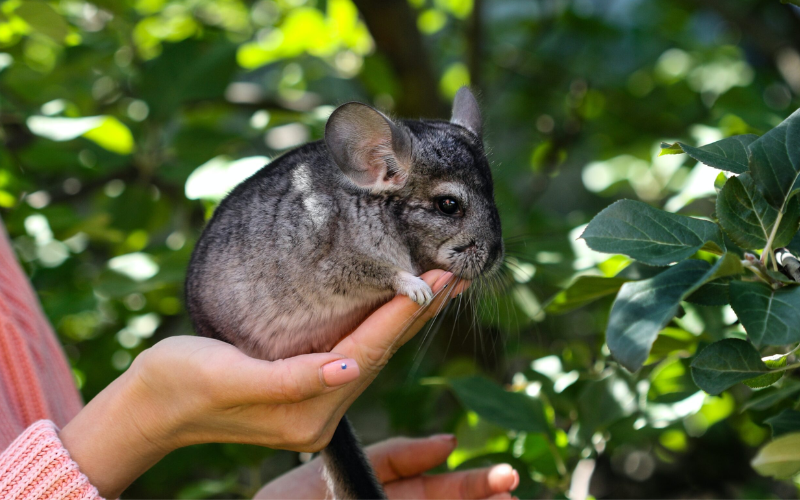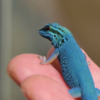- Do Turtles Need Water? - 20 July 2025
- Do Birds Have Tongues? - 14 July 2025
- Can Dogs Swim at Washington Park Denver? - 10 July 2025
Chinchillas have a striking appearance and charming personality. These small rodents are known for their luxurious fur and are sub-breeds of the chinchilla species. You might have seen the long-tailed chinchilla and the short-tailed chinchilla. Here, we reveal unique facts about Chinchillas, who are specific creatures with different colors and characteristics. Let’s get into the blog.
Chinchilla Colors and Traits
They come in various colors and showcase unique traits, making them fascinating and sought-after pets. Here are some of the common chinchilla colors and traits:
1. Standard Gray
This is the original coloration found in the wild. They have a soft and dense coat, varying in shades from light to dark gray. Such types of standard gray chinchillas are popular. Standard gray chinchillas are social animals and can form strong bond with their owners through regular interaction.
2. White Chinchillas
They have a striking appearance with their pure white fur. Their ears have a deeper tone than the rest of the body. You can locate these chinchillas at numerous breeders because of their wide availability. Their eyes are usually red or pink due to the absence of pigmentation.
3. Beige Chinchillas
These chinchillas have warm and creamy colored coats. Their fur is lighter than standard gray, and often has darker ears and feet. Beige chinchillas can exhibit variations in shade, ranging from light beige to dark caramel hues. They have pink ears and odor, an appealing appearance. The lifespan of beige chinchillas is 10 to 20 years. They are known for their friendly and social personalities. With proper handling and socialization, they can become affectionate. Breeders carefully select and pair chinchillas with desired traits to produce offspring with specific colors and characteristics.
4. Brown Velvet chinchillas
These types of chinchillas are mutations of heterozygous beige with the touch of the velvet gene. It has silky, soft brown fur. They have white fur underneath their jaws and dark eyes.
5. Pastel Chinchillas
People often know these pastel chinchillas as charcoal chinchillas. These tan chinchillas are beige crossed with ebony, which depends on the parents’ colors; either you will get light pastel chinchillas or dark pastel chinchillas.
6. Gold bar Chinchillas
These are the color variations within the chinchilla breed, which is known for their stunning golden fur. They have a unique golden coloration throughout their fur, which sets them apart from the more common gray or chinchillas. Their fur ranges from light, shimmering gold to a richer golden hue. The Gold bar chinchillas have a genetic mutation. They have a striking and luxurious appearance due to their golden fur. Fur is soft, dense, and highly prized for its unique coloration.
7. Violet Chinchillas
They are scarce, and a handful of color variations are available, from purple to dark gray. There are several chins with violet skin that are patterned. The fur of these chins doesn’t have black tips and white. Two chinchillas have crossbred to create pure violet offspring.
Other Options For Chinchilla Colors
There are the following colors and mutations for chinchilla colors:
- Blue Diamond Chinchilla
- Sapphire Chinchillas
- Wilson white Chinchilla
- Pastel Chinchilla
- Blue Chinchilla
- Mosaic Chinchilla
What Is The Care For Different Chinchilla Colors?
Caring for chinchillas of different colors involves similar principles of overall chinchilla care but specific considerations based on color variation. Here are some general guidelines for caring for chinchillas of various colors:
Housing and Environment
Despite their colors, chinchillas require spacious enclosures. You should provide a cage with multiple levels and hiding spots for exercise and stimulation. There should be proper ventilation and temperature control. Avoid placing their enclosure in direct sunlight or drafty areas.
Diet
Chinchillas should have a diet based on high-quality chinchilla pellets, fresh hay, and clean drinking water. Avoid feeding sugar or fatty treats while the basic dietary needs are the same for all chinchillas. Some color variations have specific dietary considerations or sensitives.
Dust baths
Chinchillas of all colors need regular dust baths to maintain their fur’s cleanliness and health. Provide a suitable dust bath house or container filled with chinchilla dust several times a week. The frequency may vary depending on the color variation and the individual needs of the chinchilla.
Fur Maintenance
Chinchillas have dense fur that requires regular grooming. Always provide appropriate chew toys as their teeth grow, and chew items help maintain dental health. Certain color variations have specific grooming needs or sensitivities. Keeping Chinchillas As Pets.
Are There Any Health Issues Occur Related To Color?
The color of chinchillas doesn’t relate to specific health issues. Most common health issues are related to nutrition. Give chinchilla fresh hay, which is essential as hay quickly develops mold, which can be harmful. Leafy greens, veggies, fruits, and pellets are the best additions. Nuts, rice, seeds, and bread should be avoided completely.
Chinchillas have a sensitive nature and physically active disposition. They can move quickly and sometimes without proper caution. Chinchillas could hurt themselves in several ways. Do you know chinchillas can perform a fur slip? This is a defense reflex developed to save chinchillas from predators. However, with pet chinchillas, it will likely result in damaged fur until it grows back.
FAQS
In this world peoples of keen pet sitting more want to know about chinchillas
Can Chinchillas be blue?
What color is a beige chinchilla?
Are there purple chinchillas?
What color are sapphire chinchillas?
Wrap up
We have discussed these facts about gold bar chinchilla breeders, color variations, traits, and other health concerns. It will help you provide the best care and understanding for chinchillas regarding color variation.
















